
In all our years of searching out unusual examples of the 19th century revival in France of Gothic and Renaissance furniture design, the dressoir remains one of our favorite types of cabinets and this particular one an odds-on favorite. As described more fully on our page devoted to Stylistic Origins, the dressoir is a reminder that all furniture is derived either from a chest or a table and the dressoir came from both — when a chest was first fastened onto a table so that its top became the front of a "cabinet" into whose safe space items could be locked. To be a dressoir, rather than just a cabinet, there must be an open "pot board" at the bottom. This area would have been the underneath portion of what was formerly just a table, then a back was added, and the iconic dressoir was born.
This dressoir is in the Flamboyant Gothic style popular in France at the tail end of the Middle Ages and as artists of the Renaissance began to make their way north from Italy to transform the arts (including furniture) in France. The flamb in flamboyant comes from an archaic French term for "flame" when a figure resembling a flame (and sometimes morphing into a fleur-de-lys) became an extension of the point at the top of a Gothic arch, as on this one crowning Bench 5202.
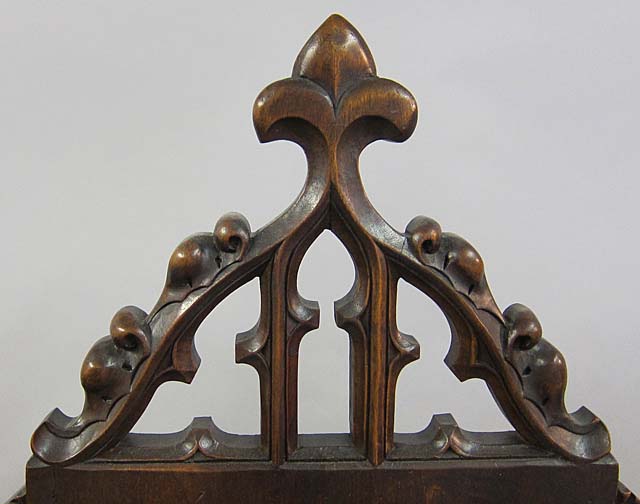
Another indication that the style is late Gothic, as reinterpreted in the 19th century, is the overall shape of the dressoir. Examples from earlier in the Gothic style, such as Dressoir 9205, retain the contours of a rectangular box; a chest atop a table. By the end of the Gothic period, the six-sided dressoir had become popular — a wide front and two narrower, angled sections on the sides, plus the back. Examples are on display at the Louvre and at the Museum of the Renaissance in Ecouen.
With five sides visible, the designer had more areas to ornament, as this dressoir demonstrates beautifully. It affirms the notion that the late Gothic style of dressoir became a sort of canvas upon which furniture makers could express themselves with elaborate carving and intricate designs, including the transition to the Renaissance when the typical arch was rounded rather than pointed. For more about this mixture of epochs as embodied in the dressoir, see the description of Item 20 from the sale at auction in 1992 of part of Bruno Perrier's collection of furniture (reference, below). In this Cabinet 5203 dating from the 19th century, elements of Renaissance art are combined with Gothic, affirming that the two were blended skillfully. The result is a masterpiece in which elements of both styles are recognizable and enthralling. This is in the spirit of the Haute Epoque, the French term for furniture made during the late 14th to early 17th centuries in what, since the 19th century, has been called Gothic and Renaissance styles.
While it is possible to treasure this remarkable piece of furniture based on its overall design and the virtuosity of the carving, a true understanding comes from interpreting the meaning of the symbols it displays. Their significance would have been evident to a French observer in the 19th century and earlier, but less so to 21st century Americans. Describing them is among the joys of being a dealer in French antique furniture.
The central story of this dressoir is the Annunciation (the Catholic feast day known as "the Annunciation of our Lady"), when the angel Gabriel appears to the Virgin Mary and informs her that she will be the mother of God's Son, Jesus. Beginning in late medieval times and into the Renaissance, the Annunciation was one of the most important of all feast days, as emphasis on the Virgin Mary intensified. Not only were Gothic cathedrals erected in her name (e.g., Notre Dame de Paris) but some of the most florid music (e.g., Marian Antiphons including the Alma Redemptoris Mater) and significant paintings were created in veneration. This affords us the perfect opportunity to discuss our two favorite paintings of the Annunciation and how elements of each may have inspired the designer of this cabinet.
The Annunciation by Fra Filippo Lippi dates from around 1440 and was probably painted for the donor of the chapel where it still hangs in the Basilica of San Lorenzo in Florence. Its placement, away from the central nave of the basilica, means that one must search it out, only to be rewarded by a sort of mutual astonishment. The angel on the left peers directly out at us as if to say, "oh, it's you," while on the right side of the painting the angel Gabriel engages with a demure but startled Mary. It is as if we are all swept up in the drama and excitement of this momentous snapshot in time. Gabriel arrives with a lily, symbol of chastity, and kneels by the Virgin Mary. Conveniently, there is a vase filled with water and sitting in its own little niche in the foreground, ready to receive the lily. The Virgin Mary's arms are raised, in reaction to the news, as she gazes downward.
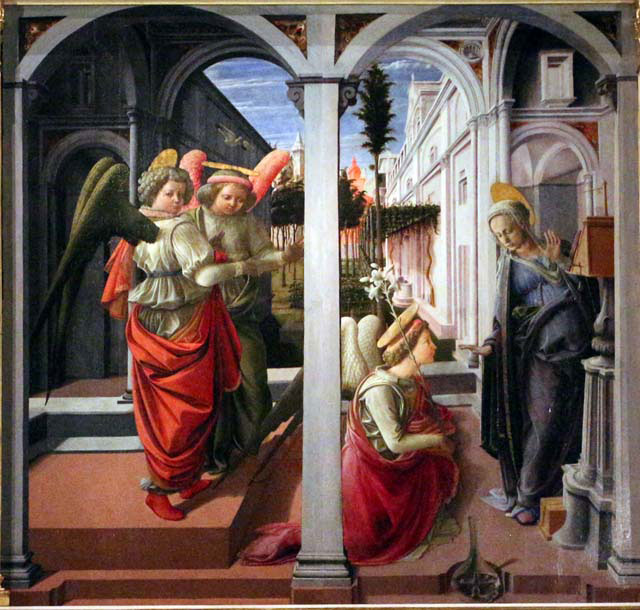
Crivelli's Annunciation is somewhat younger, done in the early 1480s for the church of the Annunciation in Ascoli Piceno in the Marches region of Italy where Crivelli fled after being exiled from Venice. Isolated from what was going on elsewhere on the peninsula for decades, he developed an enigmatic style. He continued using egg tempera rather than switching to the oil paints adopted by his younger contemporaries.
The National Gallery in London has an entire room dedicated to Crivelli where one could spend hours appreciating his genius for telling biblical stories with a sense of tenderness and awe while staged amidst details of breathtaking virtuosity such as angels' wings, Turkish rugs, richly ornamented architectural elements, and bits of produce encroaching into our space.
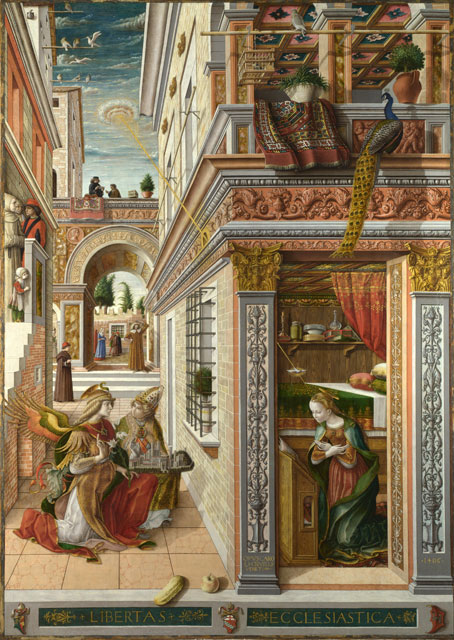
In Crivelli's Annunciation, various conversations are going on besides the central drama of Gabriel and Mary. Sprinkled around the painting, these figures add to the enigmas of this richly dramatic Annunciation. Saint Emidius is there too, with Gabriel, since he was martyred in Ascoli Piceno albeit after the events that the Annunciation heralds. This time, we as the viewers are not invited into the drama. But we still get a peek into the home of the Virgin and the trappings of domesticity as imagined by Crivelli for the moment when she learns what God has in store for her. Details such as the grain of the chestnut wood comprising the lectern and the wall behind her bed have been faithfully rendered by Crivelli. The rug beneath her feet is rumpled, as if she scrambled to stabilize her footing when the angel's arrival startled her. The bedding and curtains behind her fold gently and are rich in decorative patterns. Her ordinary life, evoked by all these elements, is about to be transformed.
It is not possible to know if the creator of our cabinet knew these paintings but it is tempting to speculate that he drew favorite elements from both. For example, the angel in the panel on the left side of the dressoir kneels, facing to the right. His robes billow and flow about him, as if he has just landed in Lippi's scene. But his wings are at rest as he wields a rod angled upward over his head, rather than the lily proffered by Lippi's angel. Perhaps a lily would have been too difficult to carve into the solid oak of this cabinet? Instead of the pillar, supporting an arch and behind which we find Lippi's angel, the angel on our cabinet is framed by an elaborate rounded arch with diagonal ornaments and a zig-zag pattern at the top, as if at the entrance to a side chapel in a Gothic cathedral.
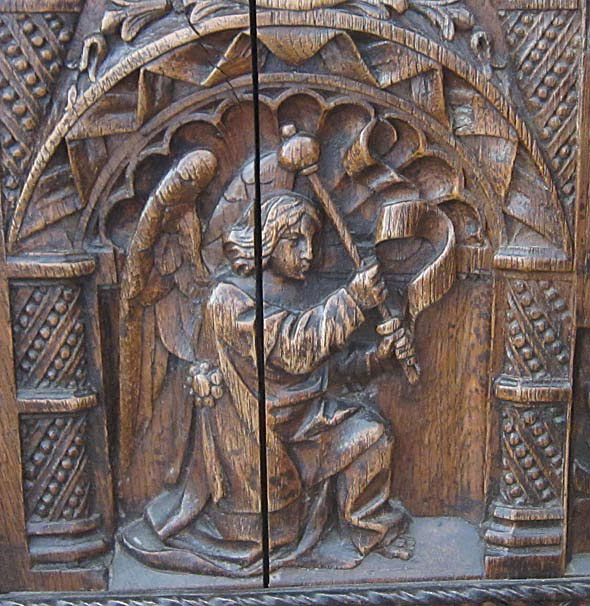
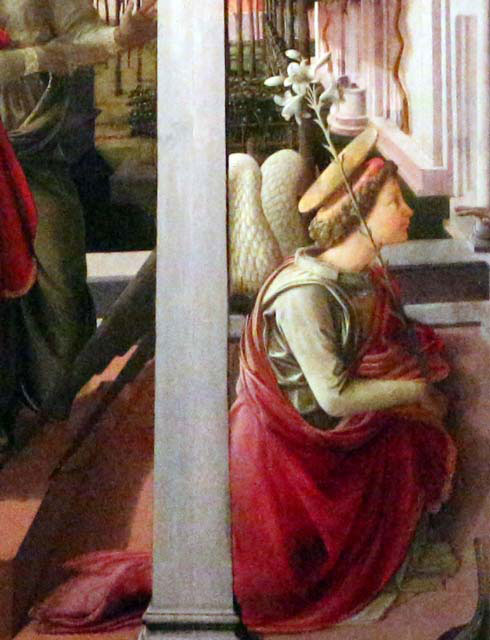
The Virgin Mary, the focus of the panel on the right side of the cabinet, resembles more the figure in Crivelli's version of the Annunciation than Lippi's. Rather than appearing to recoil at the angel's words as in Lippi's painting, Crivelli's Virgin leans slightly forward with her arms crossed in front of her chest. Her attitude is reverent and she seems intent on what she has been reading. Shown in three-quarter profile, were she to turn just a bit toward us, her pose would mirror the one on the cabinet where she is surrounded by a broad, rounded arch, similar to the one around the angel, but with circular ornamentation rather than a zig-zag pattern at the top.
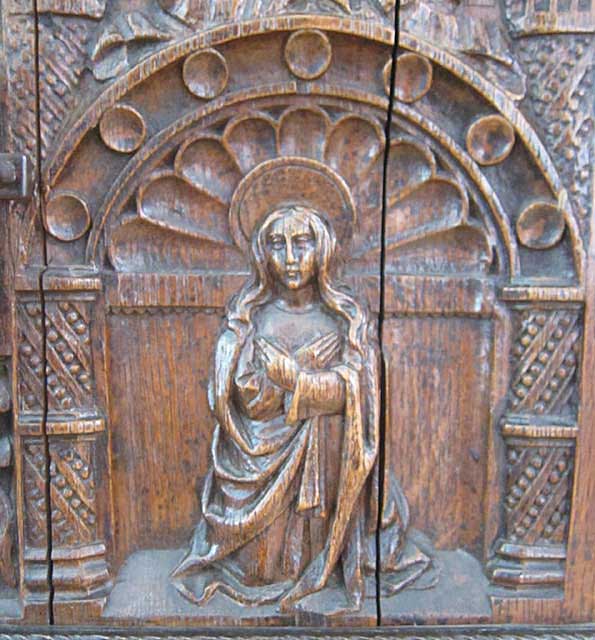
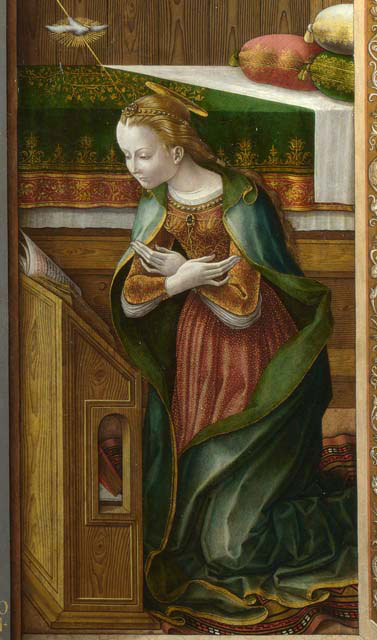
On our cabinet, the angel is placed within the confines of a larger panel rich in intricately carved details and symbolism. In both the Lippi and Crivelli versions of the Annunciation, there is a background of deep perspective filled with portions of buildings. On the cabinet, there is what looks like part of a building above the archway in which the angel kneels and, on either side, are what look like sections of columns with the same diagonal pattern as on the arch framing the angel. In the foreground is a large vase with the same diagonal ornamentation.
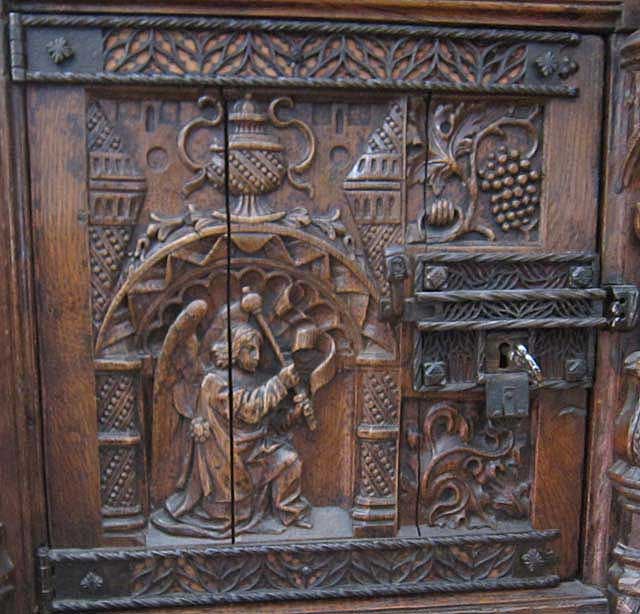
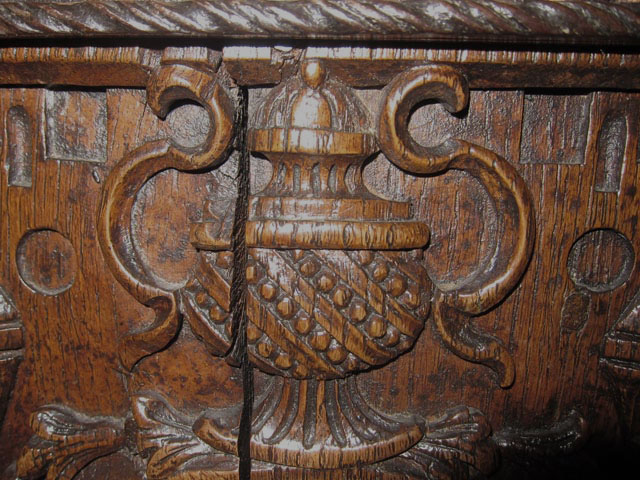
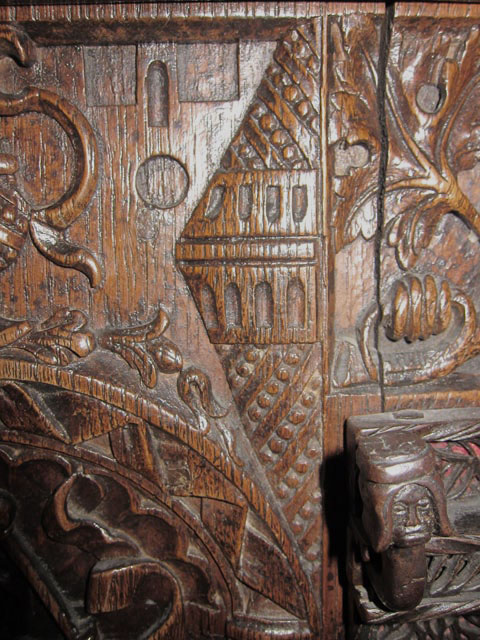
On the angel's panel at the upper right, above the lock, is a square containing a bunch of grapes, grape leaves, and a spiral section of vine. Grapes and wine are frequently used symbolically and literally in the Bible but perhaps the meaning here is from the Gospel of John (15:1-6)* where the vine and branches symbolize the unity of Jesus with his believers. The same motif is seen above the lock on Cabinet 5197.
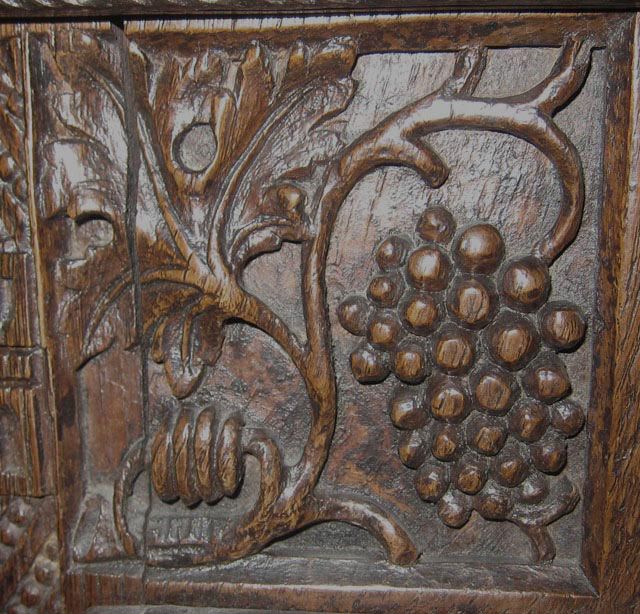
Just below the lock is a small square panel containing elaborate carving of acanthus leaves unfurling. Perhaps more than any other vegetation, the acanthus leaf has been the ornament of choice for its versatility (furled, unfurled, crocketed) in both Gothic and Renaissance design but with its origins in the architecture of ancient Rome where it was used to fill blank spaces and to add elegance. In placement and design, this too mimics Cabinet 5197.
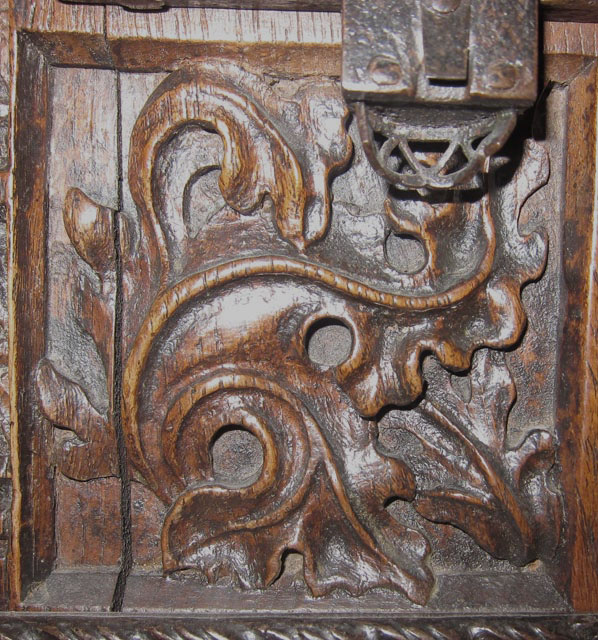
On the right side of the cabinet, the larger panel dedicated to Mary has a background of architecture almost identical to the one used for the angel's panel but ribbons below a sunflower have been substituted for the vase.
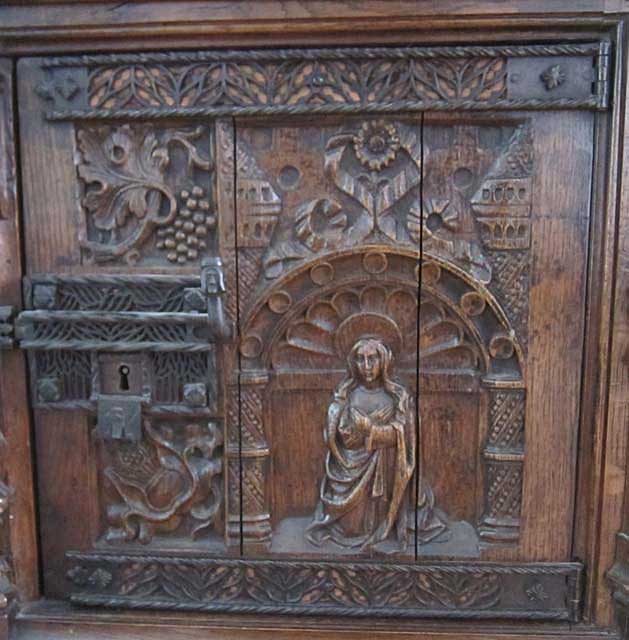
The exceptional hardware on this door panel, and the one to its left, is harmonious with the overall decorative themes of the cabinet. For example, the metal straps at the top and bottom include a pattern of tracery consisting of elliptical designs within repeating arches. The lock itself uses similar figures but in an even more intricate series of patterns. Forming the base of the lock is a row of tiny lancet arches.
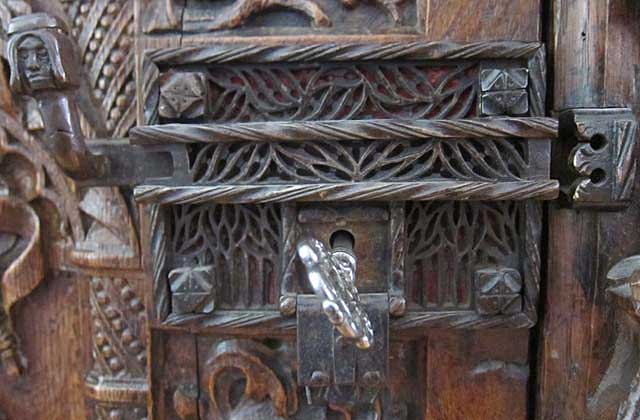
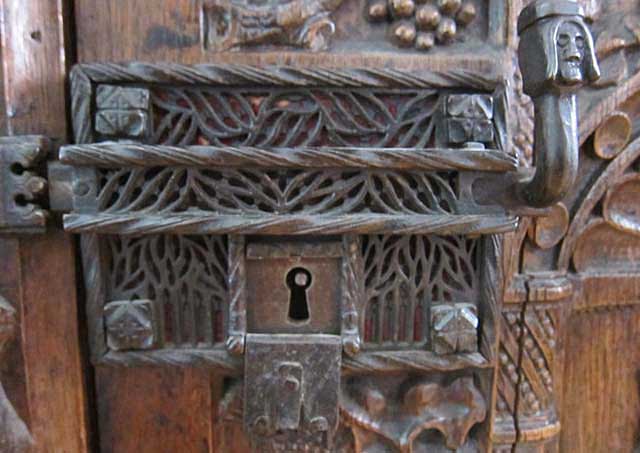
In addition to locking with a key (one key opens both left and right doors and the central door below them) there are sliding mechanisms that control the opening of the doors. The system is ingenious. Tiny covers flip up to hide the locks for the left and right doors. If the sliders are pushed all the way in toward the center of the cabinet they will lock without the key and will only open if the key is turned all the way while moving the slider at the same time. On the knob used to move the slide is a face — a simple rendering of features framed by a page-boy hairdo and topped with a hat.
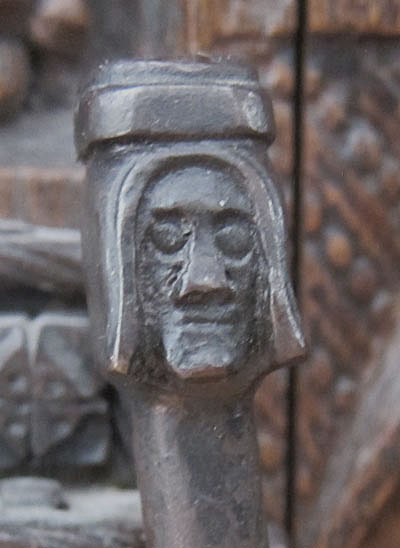
The squares of carved decoration above and below the lock on this right-hand door of the cabinet are similar but distinct from those on the left. While the upper square contains grape leaves and a bunch of grapes there is no stem as on the left.
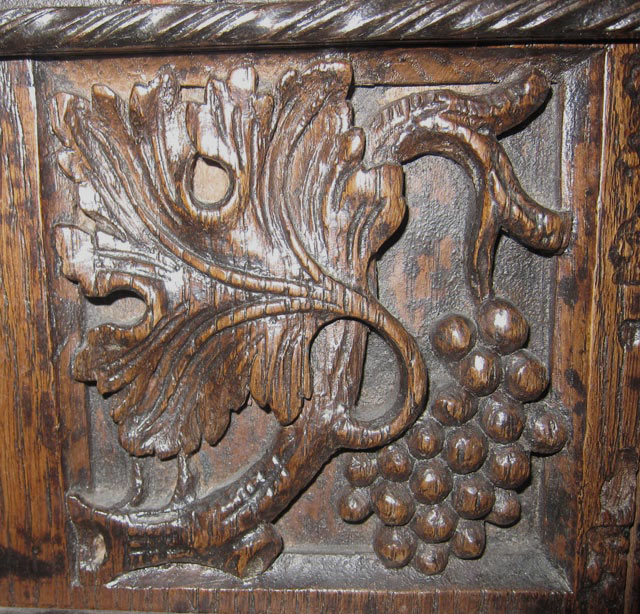
Below the lock, on the right side, is a carving of a pomegranate with its seeds exposed. The use of this fruit in symbolic terms goes back to ancient times but in the context of Christianity it signals Christ's death and resurrection, foreshadowing the events that will come into play as a result of the Annunciation depicted on the cabinet. It is also symbolic of the Church with the innumerable seeds symbolizing its members. A similar pomegranate figure is seen in the Crivelli Annunciation within the golden capital of the column at the left side of the Virgin's house.
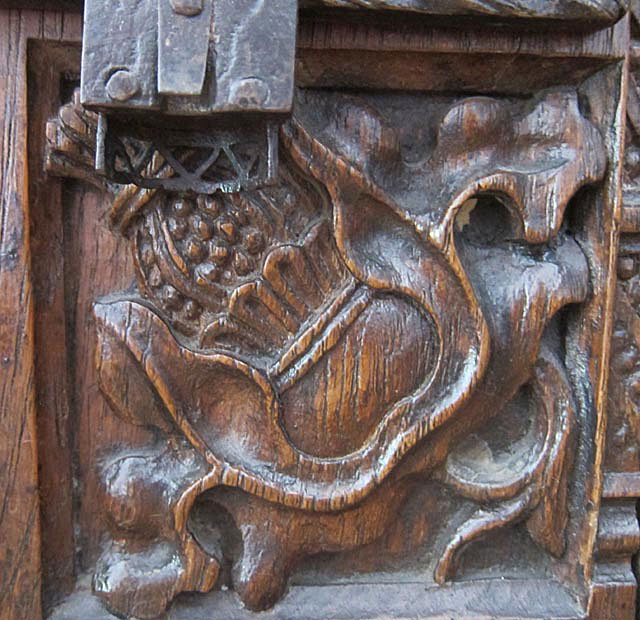
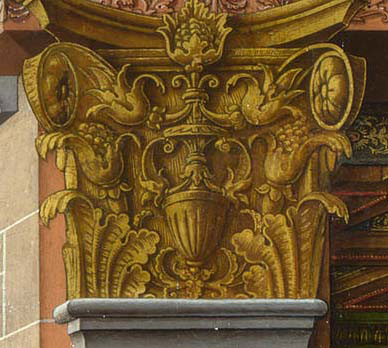
Between the two doors of this upper part of the dressoir is an elaborate carving that remains almost completely intact. Starting from the bottom, it consists of a pedestal supporting a vase. The vase is elaborately ornamented, including the diagonal pattern seen on the columns of the arches framing the angel and the Virgin as well as on the vase above the angel's head.
From the vase, a tall lily plant with three unopened blooms extends upward. As mentioned above, the angel Gabriel is supposed to have brought with him to the Annunciation a lily to present to the Virgin Mary. Although this is not represented in the Biblical account of the Annunciation, the lily is present in many artistic renderings of the event, especially by painters of the Italian Renaissance including in the two examples discussed above.
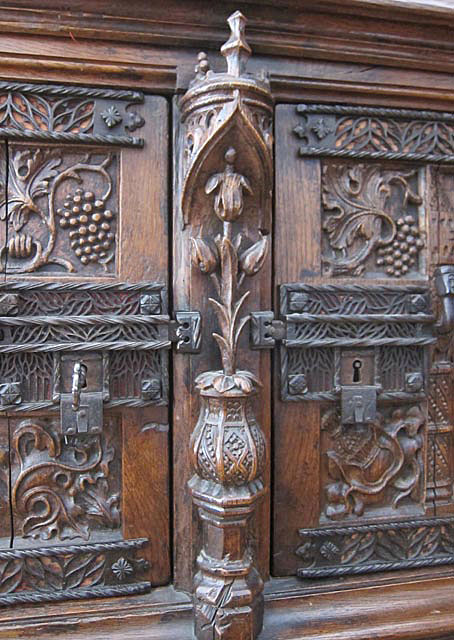

At the top of the central element is an intricately carved canopy extending out over the central figure of the vase and lily. Its design includes tiny lancet arches (tall and thin) giving a decidedly Gothic context to this part of the cabinet, reminiscent of the canopies framing the column-like figures of saints and prophets surrounding the doors of Gothic cathedrals.
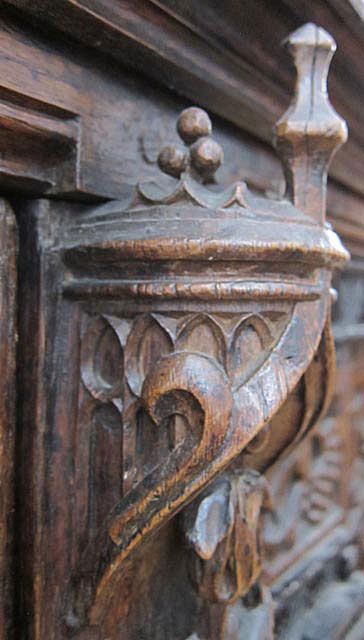
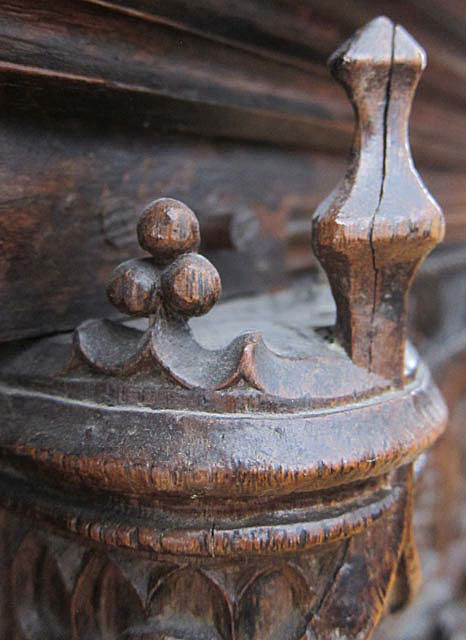
The lower part of the top of the cabinet involves only one door but another richly carved panel. This time, there is no story to tell. Rather, this would have been the panel on which some element identifying the cabinet's owner could have been carved. The main panel contains a flamboyant arch, topped by an elaborate flame-like figure, which acts as a frame for the central elements. Above this arch are lancet arches. Along the sides of the main arch are extensive crockets (curled acanthus leaves).
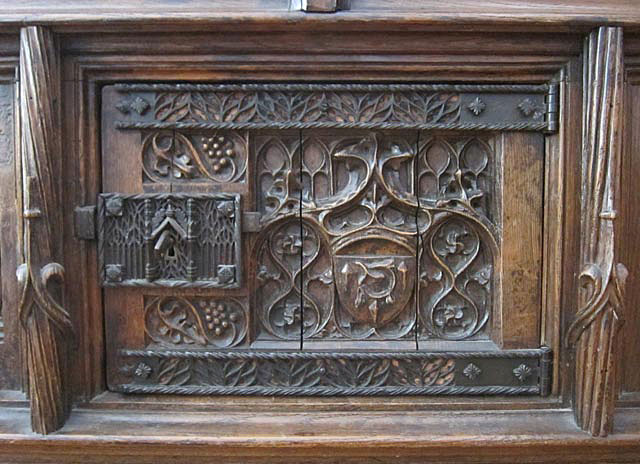
At the top and bottom of the lock are small rectangular panels containing Gothic fenestrage or tracery in the form of soufflet figures (wide at one end and narrow at the other as in a bellows that provides a souffle or breath to a fire) framing a grape leaf and a bunch of grapes. The tracery is based on designs found in Gothic cathedrals, especially framing the pieces of stained glass in windows.
As the focus of this lower door panel is a shield bearing a coat of arms. Our research has not identified the central elements or what they symbolize. They appear to be bits of branches — perhaps a broken crown of thorns? This would fit with what seem to be three crosses at the outer edges of the shield, carved in a manner making them appear to arise from a sand pile. If so, this door panel hints, symbolically, at the end of the story of Jesus' life that began with the Annunciation shown on the panels above it.
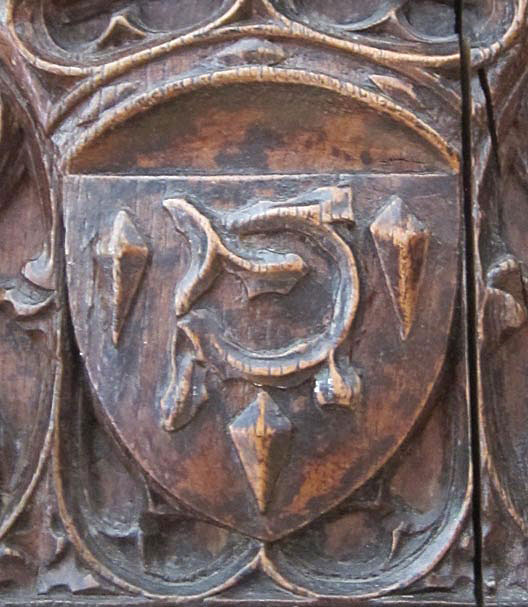
The lock used for the door on this lower part of the cabinet is related in design but different from the locks used on the two doors above it. For example, there is no slide mechanism. Rather, it simply opens with the key. But in design it is Gothic and complex, in the tiny spaces inhabited by elliptical bits of tracery and, as in the other two locks, a row of lancet arches at the base. The graceful sweep of the elements in the upper parts of the tracery mimic that of the panels on the sides of the dressoir (shown below).
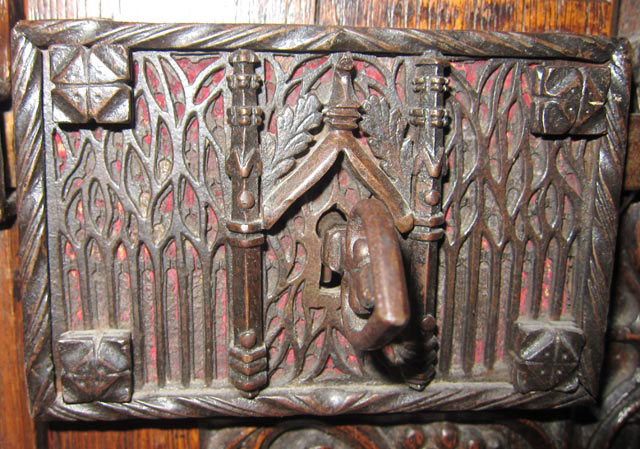
It is remarkable to find the hardware on this cabinet intact, considering how often iron elements of furniture were melted down for armaments or other objects of value. Was it simply too beautiful to destroy? Or was this cabinet always in some protected location? The locks are works of art in their own right and unlike anything we have ever seen. They harmonize exquisitely with the Gothic elements carved so exquisitely on the oak panels.
The narrow splits in the oak, running the full extent of the height of all three door panels, have not been altered. They are the result of the wood adjusting to changes in temperature and humidity over the years and are a reminder that this piece has been around for a century and a half — with more centuries of enjoyment and appreciation in store.
On either side of the lower door on the front of the cabinet are two matching panels based on Gothic tracery. Between columns ornamented by diagonal lines are undulating figures of tracery based on elliptical shapes filled with tiny quatrefoils whose leaves extend to points. At the top is a stylized scallop shell or coquille Saint-Jacques symbolic of St. James and pilgrimages since medieval times to the shrine of Santiago de Compostela in Spain.
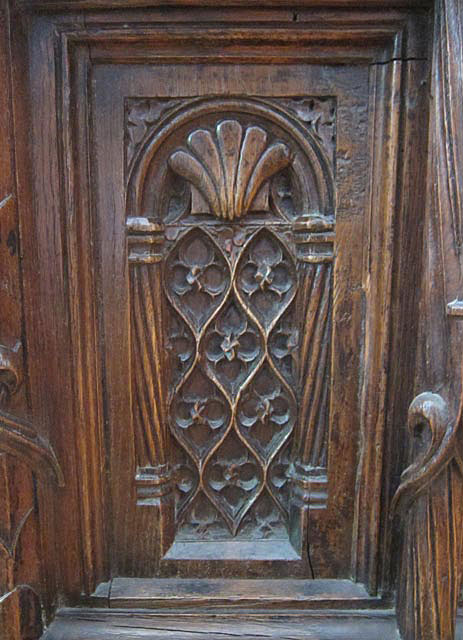
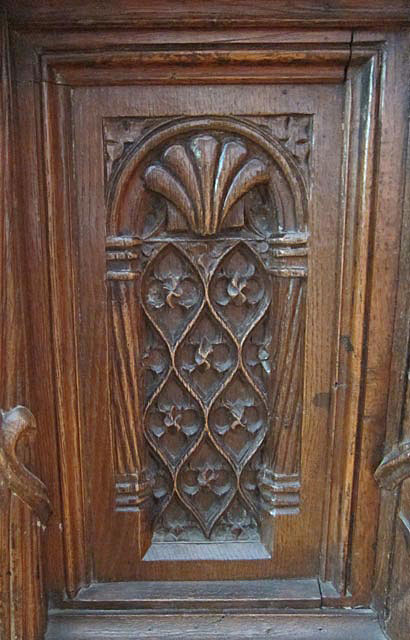
The rich carving and intricate details that make this dressoir so exquisite are not limited to the door panels or to the front of the cabinet. The angled side panels offer their own interesting designs and rich ornamentation all within rounded arches ornamented with small pearl-like figures.
The panels on either side of the upper part of the front of the cabinet are matching treatments of an extremely elaborate fleur-de-lys that is unusual in several respects. For example, the central petal is unusually tall in proportion to the petals on each side and is rounded at the top instead of pointed. Unifying the central element of the fleur-de-lys with ornamentation on the front doors of the cabinet is the diagonal decorative motif obscured by carved bits of leaves. On either side of the fleurs-de-lys are elliptical tracery patterns with quatrefoils similar to those of the panels on either side of the lower door of the cabinet.
The top of the fleur-de-lys is bordered on either side by tracery in the shape of elliptical mouchettes. Extending above the central petal and between the mouchettes is a cross. Above the arches containing the fleurs-de-lys are slightly elongated (horizontally) versions of the figure of grape leaf and bunch of grapes contained in tracery above and below the lock on the lower door panel. The photo on the left, below, shows the spires found on either side of the panels, separating them architecturally as the eye moves from front to back of the cabinet. These are fleurs-de-lys with heft, making an emphatic statement that this is a French cabinet by evoking one of France's most enduring symbols.
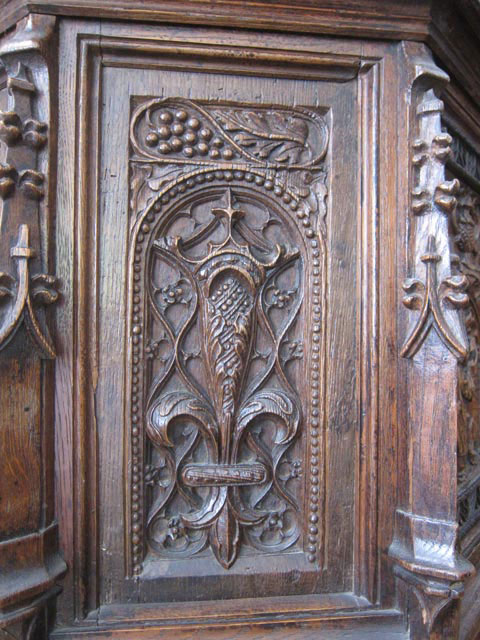
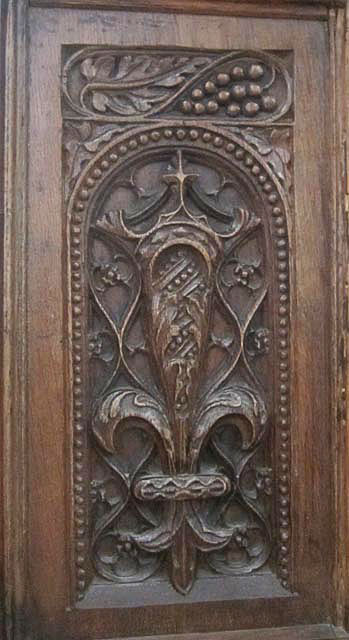
Below the fleur-de-lys on the right side of the cabinet is a panel containing a tall column on which a rooster, the unofficial national symbol of France, sits. We can tell it is a rooster thanks to its comb. The feathers are richly carved and its wings are spread. As with the fleurs-de-lys, the column and rooster are surrounded by tracery, including elliptical shapes framing quatrefoils. It remains a possibility that the rooster was a heraldic symbol used by whoever commissioned this cabinet, especially considering the crossed elements on the column, some sort of weapon with a bushy head.
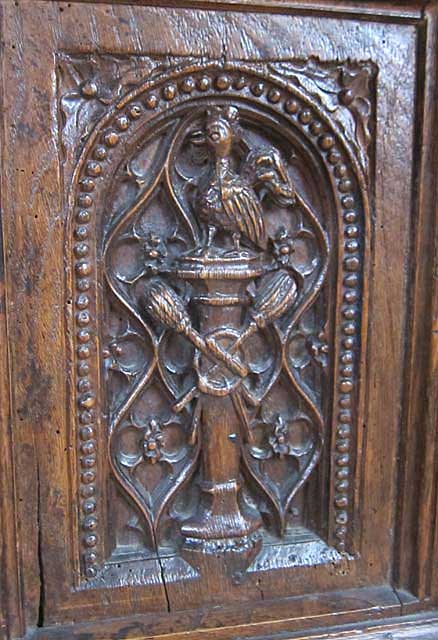
We have encountered roosters before, as elements of heraldry. For example on Cabinet 5112B a pair of roosters appears to dance and crow at the same time. The rooster on this cabinet (below, on the right) faces toward the dramatic action depicted on the main panels of the front of the dressoir. Its mouth open, it is as if the rooster is about to sound a cock-a-doodle-do. Perhaps it was his job to awaken the Virgin Mary in advance of Gabriel's arrival. Or the cock may be a reminder of Peter's disavowals of Jesus, whose birth is yet to come after the events depicted on the front of the cabinet.
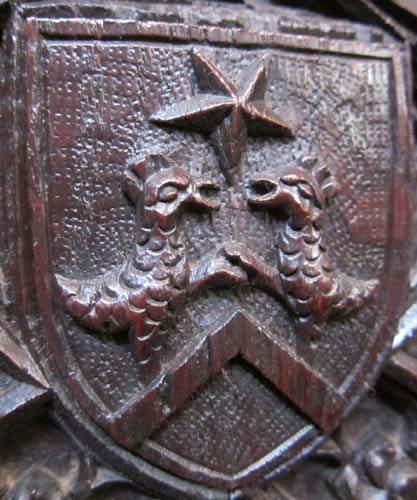
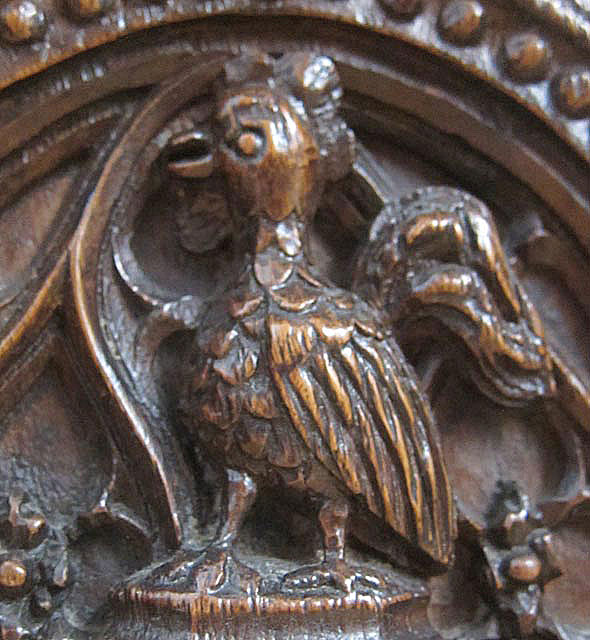
On the angled side of the dressoir, the upper panel on the left is of the fleur-de-lys, as discussed above. Below it is a panel of Gothic tracery whose central element is a cross sitting above a vase and surrounded by the same elements of tracery used in the other panels on the angled sides of the cabinet.
The cross merits close examination. Instead of uniform and even pieces of wood, the cross is asymmetrical and not straight, a potent symbol of an instrument of death hewn from what was once a living organism. At its top it splits in two just above a knot on the right side. Its arms end in short branches. On the vertical element is a texture resembling tree bark. Bulbous knots jut out of it as if to represent the pain in store for Mary and her Son when His death on the cross ends the earthly days of the child foretold by Gabriel.
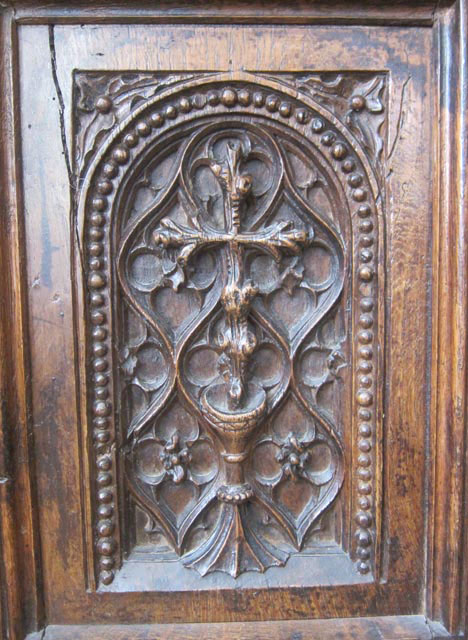
The last two panels on each side, before reaching the back of the cabinet, are based on three lancet arches at the bottom and distinct tracery patterns above them. The upper panels include elliptical shapes and quatrefoils, as seen elsewhere on the cabinet. On the left, there is the addition of a carved floral design while on the right the tracery itself is the focus with sweeping curves containing narrow mouchettes. Both panels are contained within an overall, rounded arch, perhaps a nod to the Renaissance style taking over from the pointed arch of the Gothic style whose characteristic tracery is so beautifully interpreted.
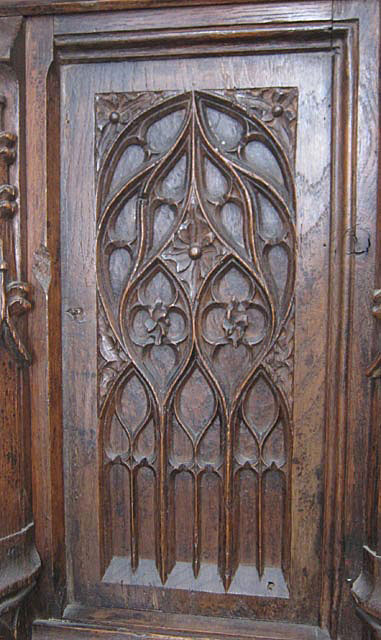
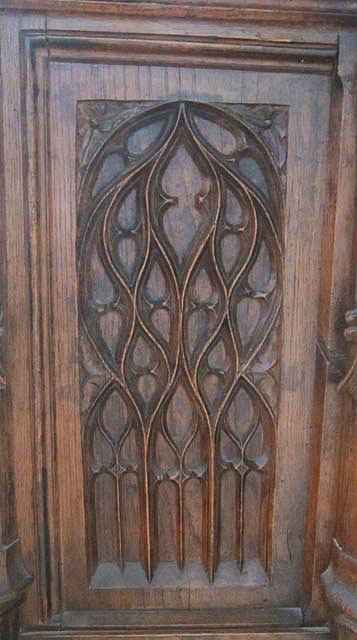
The lower panels on both sides are similar but not identical. Over the row of lancet arches, each panel includes tracery that is framed by a larger pointed arch. Instead of quatrefoils, spaces are filled with floral designs.
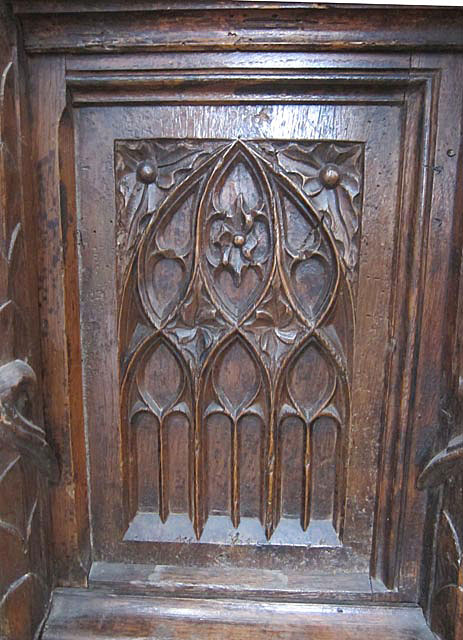
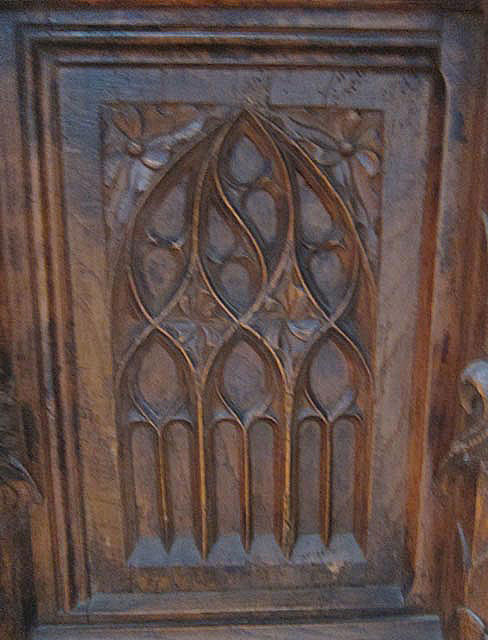
Between each of the sides of the cabinet, with the exception of the elaborate central divider, is a vertical carving of a Gothic spire. This can be viewed as the ultimate in Gothic accents on a piece combining architectural elements of both Gothic and Renaissance styles. The role of spire as divider is mirrored in the design of all three of the locks on this cabinet where spires divide each lock into three sections. Ultimately, the spire harks back to its role atop Gothic cathedrals, representing a reach toward heaven by the faithful who dedicated their lives to erecting these churches.
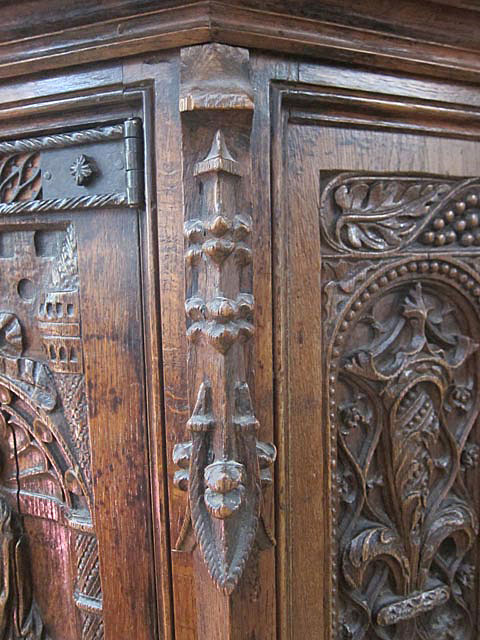
Below the case portion of the dressoir is a classic pot-board, designed for displaying items such as ceramics and silver. The vertical panel comprising the back consists of a series of linen-fold (pli-de-serviette) panels. It is hard to think of a decorative element more fungible than the linen-fold, used throughout the Gothic period and in its 19th century revival, especially for portions of furniture less visible or deserving of elaborate carving. Many variations on this theme were developed by furniture-makers and in some cases the linen-fold is the star, as in Chest 3216.
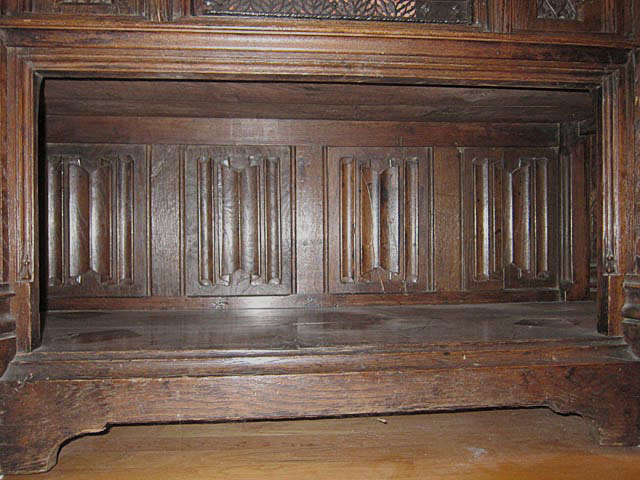
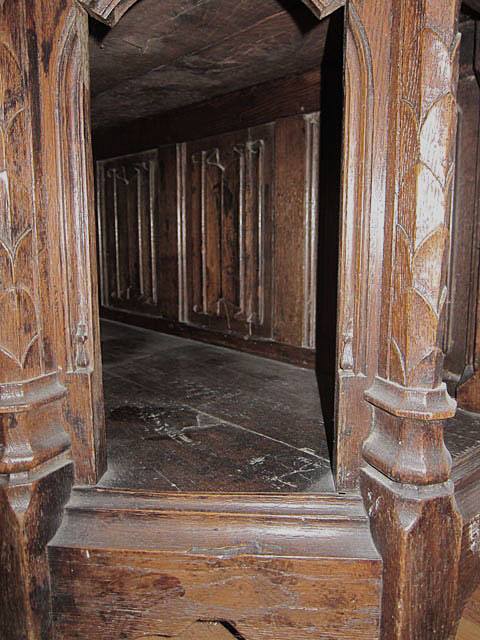
As we learned subsequent to acquiring this cabinet, its "twin" was at one time in the home of the late Jacqueline Boccador, Paris antique dealer and one of the world's foremost experts on French furniture of the Haute Epoque. The following photo was contained in a catalogue for the auction of the contents of Mme Boccador's apartment after her death.
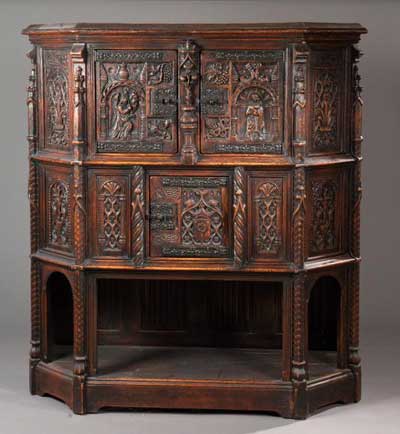
Why would an expert on the output of the original period, such as Jacqueline Boccador, choose to live with a 19th century copy (albeit an antique in its own right)? It is tempting to speculate. Perhaps she had seen the 16th century version at the Cluny (discussed, below) but could not own it and so opted for the next best thing, a remarkable copy albeit from the 19th century? Perhaps the story of the Annunciation, depicted so exquisitely in the carving, was a source of inspiration in her daily life? Perhaps she just enjoyed being around it, as we have with our own version.
Although the hardware is far less elaborate than that on our cabinet, the carvings on the door panels are almost identical with the exception of the coat-of-arms on the door of the lower part. There, the shield has three barely discernible crosses (or perhaps, ermine tails?). The central element is clearly a crown of thorns.
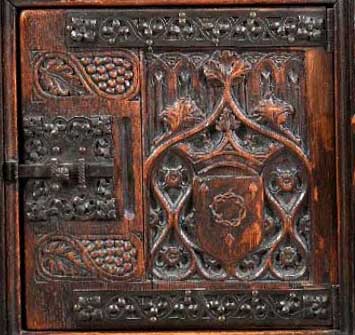
Both our piece and Mme Boccador's may have been based on a dressoir in the collection of the Museum of the Middle Ages (also known as the Cluny) in Paris. The similarity of the panels, especially those depicting the Annunciation, is striking. According to the Cluny's catalogue published in 1925, Dressoir 511 (CL142) was made in the early 16th century in France. We have been able to locate this photo, but only in black and white. During countless visits to the museum over a period of four decades, we have never seen this cabinet on display.
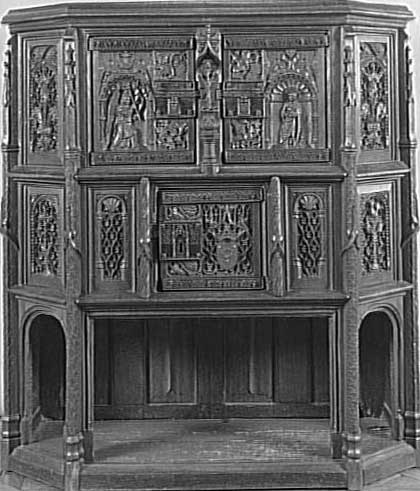
While our remarkable dressoir may never be united with its far-off "twin," or the 16th century museum piece that was likely its inspiration, it remains a unique and treasured piece in its own right for anyone who appreciates the furniture of the Haute Epoque and the mastery of 19th century craftsmen who were faithful to it.
Reference
Ader-Tajan, Collection Bruno Perrier Haute Epoque (Catalog for Sale at Auction on April 6, 1992 at the Hôtel Drouot, Paris); Boccador, Jacqueline, Le Mobilier Français du Moyen Age à la Renaissance (Editions d'Art Monelle Hayot, Saint-Just-en-Chaussée, 1988); Bos, Agnès, Mobilier du Moyen Age et de la Renaissance — La Collection du Musée du Louvre (Editions du Musée du Louvre/Somogy, Paris, 2019); Grenon, Thomas, Ed., France 1500 — Entre Moyen Age et Renaissance (Réunion des Musées Nationaux, 2010); Haraucourt, Edmond, Catalogue des Bois Sculptés et Meubles (au Musée des Thermes et de l'Hôtel de Cluny) (Musées Nationaux, Paris, 1925); Stemp, Richard, The Secret Language of the Renaissance, (Duncan Baird, London, 2006); Thirion, Jacques, Le Mobilier du Moyen Age et de la Renaissance en France (Editions Faton, Dijon, 1998); Viollet-le-Duc, Eugène, Le Mobilier Médiéval (Georges Bernage, editor) (Editions Heimdal, 2003)
Uses
This cabinet is one of those rare pieces whose intricate carving demands close examination and so should be in a well-lit location and preferably with chairs nearby, such as Item 5213 for admirers to pull up and sit as they enjoy viewing it.
*John 15:1-6 (NIV). I am the true vine, and my Father is the gardener. 2 He cuts off every branch in me that bears no fruit, while every branch that does bear fruit he prunes so that it will be even more fruitful. 3 You are already clean because of the word I have spoken to you. 4 Remain in me, as I also remain in you. No branch can bear fruit by itself; it must remain in the vine. Neither can you bear fruit unless you remain in me. I am the vine; you are the branches. If you remain in me and I in you, you will bear much fruit; apart from me you can do nothing. 6 If you do not remain in me, you are like a branch that is thrown away and withers; such branches are picked up, thrown into the fire and burned.